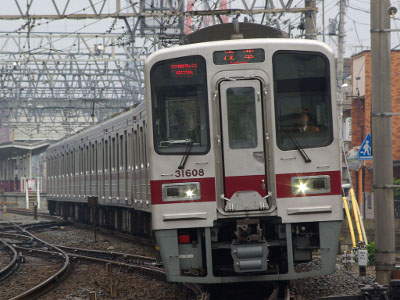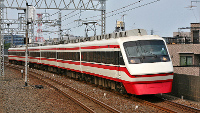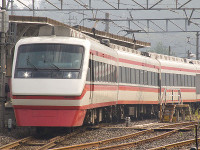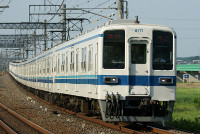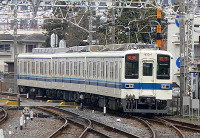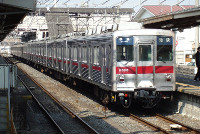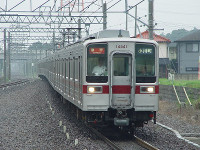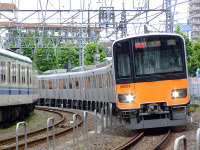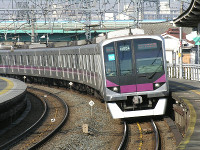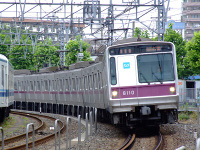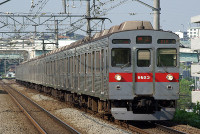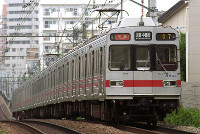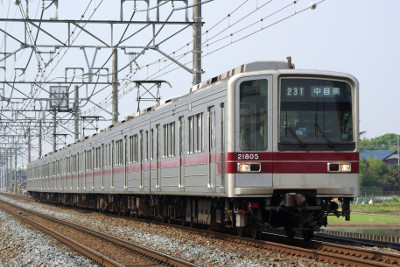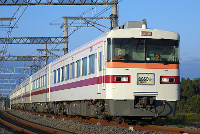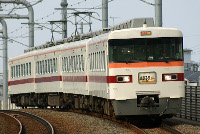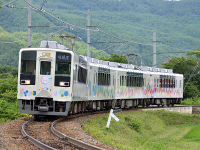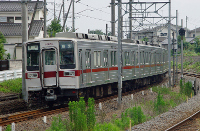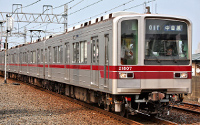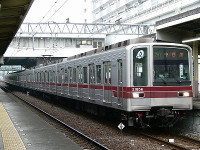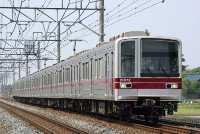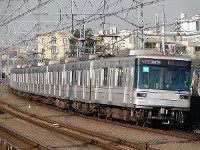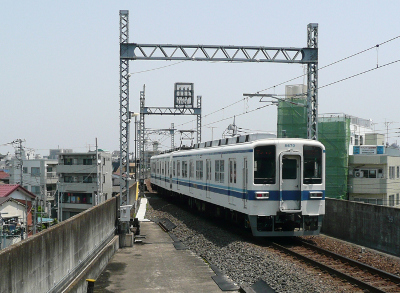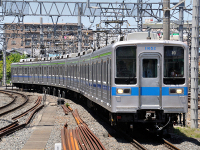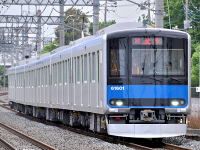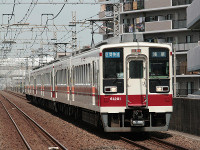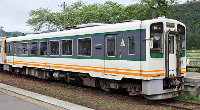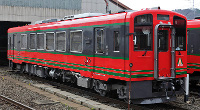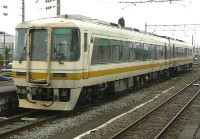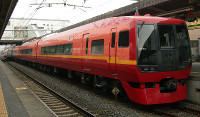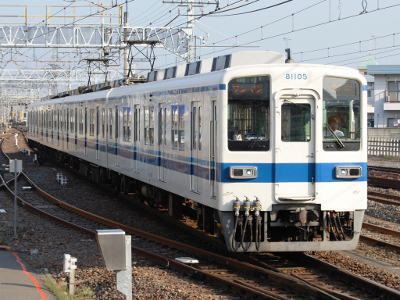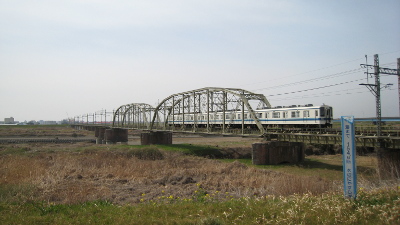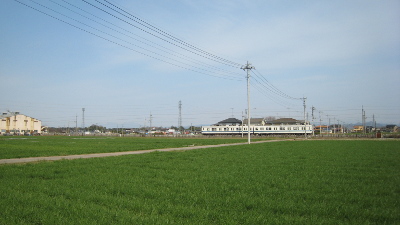Tobu Lines
This is the page for all Tobu Lines
- Isesaki Line
- Skytree Line
- Kameido Line
- Daishi Line
- Urban Park Line
- Nikko Line
- Utsunomiya Line
- Kinugawa Line
- Sano Line
- Koizumi Line
- Kiryu Line
- Tojo Line
- Ogose Line
Isesaki Line
The Tobu Isesaki Line (東武伊勢崎線 Tōbu Isesaki-sen) is a Japanese railway line operated by the private railway company Tobu Railway, extending from Tōbu-Dōbutsu-Kōen Station in Saitama to Isesaki Station in Gunma Prefecture. From March 2012, the southern 41.0 km section of the line was rebranded as the Tobu Skytree Line in conjunction with the opening of the Tokyo Skytree topwer.
Between Tōbu-Dōbutsu-Kōen and Tatebayashi the tracks are double track and between Tatebayashi and Isesaki the tracks are single track
Service Patterns
Stops and operated sections are as of 2013.
Local (普通 Futsū) (announced as Kakueki Teisha (各駅停車) or kakutei (各停) for short) (L)
Tōbu-Dōbutsu-Kōen − Ōta. Connection with Express. Three per hour, with one between Kuki and Tatebayashi.
Ōta − Isesaki. One per hour per direction, conductorless.
Section Semi-Express (区間準急 Kukan Junkyū) (SSE)
Between Asakusa and Tōbu-Dōbutsu Kōen, Kuki or Minami-Kurihashi on Nikkō Line.
Semi-Express (準急 Junkyū) (SmE)
Early morning and late night. Down to Tōbu-Dōbutsu-Kōen, Kuki or to Minami-Kurihashi on the Nikkō Line through from Chūō-Rinkan of Tokyu Den-en-toshi Line via Hanzōmon Line. 10 cars.
Section Express (区間急行 Kukan Kyūkō) (SE)
Between Asakusa and Tōbu-Dōbutsu-Kōen, Tatebayashi, Ōta or Shin-Tochigi on the Nikkō Line.
Express (急行 Kyūkō) (Ex)
From morning to night. Down to Tōbu-Dōbutsu-Kōen, Kuki (nearly half to Minami-Kurihashi on the Nikkō Line), through from Chūō-Rinkan on the Tokyu Den-en-toshi Line via Hanzōmon Line. 10 cars.
Limited Express (特急 Tokkyū) (LE)
Stops not shown. Charged for seat reservation and rapid service. Mainly through to the Nikkō Line for the Nikko area named Kegon (けごん) and Kinu (きぬ). Some through to Isesaki from Asakusa, sole direct service named Ryōmō (りょうもう).
History
The first section of the Isesaki Line was opened by the present company in 1899 between Kita-Senju and Kuki utilising steam motive power. In 1902, Tobu extended the line south to have a maritime connection at present Tokyo Skytree (then Azumabashi (吾妻橋), later renamed Asakusa) in downtown Tokyo, and north to Kazo. The following year a further northern extension to Kawamata (then on the south bank of Tone River) was opened. Further northward extension progressed, and in 1910 the line arrived at Isesaki. In 1931, a bridge over the Sumida River was built and present Asakusa Station (then Asakusa Kaminarimon (浅草雷門)) opened as part of the department store building, the entire line being completed.
The Asakusa to Nishiarai section was double-tracked in 1912, and the rest of the line was double-tracked between 1920 and 1927, with the exception of the Hanyu to Kawamata section, which was double-tracked when a second bridge was built over the Tonegawa in 1992.
Electrification was begun in 1924 on the section of Asakusa and Nishiarai, and in 1927 completed as far as Isesaki. The distance of over 100 km was then one of the longest electrified railway lines together with the present Kintetsu Osaka Line and Kintetsu Yamada Line.
After World War II, the Tobu Lines had no connection to the Yamanote Line or other major lines of the then Japanese National Railways (JNR) to offer efficient transfers to central Tokyo. The sole connection was with the Jōban Line at Kitasenju, which offered poor access to central Tokyo. To solve the inefficiencies of transfers at Kitasenju and notoriously narrow Asakusa, in 1962, the Hibiya Line of the then Teito Rapid Transport Authority (帝都高速度交通営団 Teito Kōsokudo Kōtsū Eidan), known as TRTA, present Tokyo Metro) was built, connecting at Kitasenju.
Further growing traffic required Tobu to build a second through line to Tokyo Metro Hanzomon Line in the 1990s. In 2003, the company built new tracks from Hikifune to connect at Oshiage, officially an annex station of Tokyo Skytree.
From the March 3, 2006, timetable revision, less than half of trains originated or terminated at Asakusa, with more trains operating through to Tokyo Metro underground (subway) lines.
From 17 March 2012, the section south of Tōbu-Dōbutsu-Kōen was rebranded as the Tobu Skytree Line.
Station List
Here is the station list of the Isesaki Line from Tobu Dobutsu Koen (for transfers to other lines look at the page of the station).
- Tobu Dobutsu Koen
- Wado
- Kuki
- Washinomiya
- Hanasaki
- Kazo
- Minami Hanyu
- Hanyu
- Kawamata
- Morinji Mae
- Tatebayashi
- Tatara
- Agata
- Fukui
- Tobu Izumi
- Ashikagashi
- Yashu Yamabe
- Niragawa
- Ota
- Hosoya
- Kizaki
- Serada
- Sakaimachi
- Goshi
- Shin Isesaki
- Isesaki
Current Rolling Stock
Tobu 200 Series
Tobu 250 Series
Tobu 1800 Series
Tobu 8000 Series
Tobu 850 Series
Tobu 10000 Series
Tobu 10030 Series
Tobu 30000 Series
Tobu 50050 Series
Tokyo Metro 08 Series
Tokyo Metro 80000 Series
Tokyu 5000 Series
Tokyu 8500 Series
Tokyu 8590 Series
The Skytree Line
The Tobu Skytree Line (東武スカイツリーライン Tōbu Sukaitsurii-rain) is a Japanese railway line operated by the private railway company Tobu Railway, extending from Asakusa Station in Tokyo to Tōbu-Dōbutsu-Kōen Station in Saitama Prefecture. Some trains from the line continue to the Tokyo Metro Hibiya Line and Tokyo Metro Hanzōmon Line. Formally the southern part of the 114.5 km long Tobu Isesaki Line, it was rebranded the Tobu Skytree Line on 17 March 2012 in conjunction with the opening of the Tokyo Skytree tower.
The Tracks of the line are between Tokyo Skytree - Hikifune 1.3 km (including Oshiage) and Kita-Senju - Kita Koshigaya 18.9 km quadruple and the rest double.
Operation
All-stations "Local" services operate from Asakusa to Kita-Senju, and Tōbu-Dōbutsu-Kōen, and onward to Minami-Kurihashi on the Tōbu Nikkō Line. Some peak-hour Local services from Asakusa terminate at Takenotsuka, Kita-Koshigaya, or Kita-Kasukabe.
Through trains
The Skytree Line has trains that inter-run with two Tokyo Metro subway lines. One is the Tokyo Metro Hibiya Line connected at Kitasenju, with all-stations "Local" trains only. The other is the Tokyo Metro Hanzōmon Line at Oshiage, with rapid trains of Tobu. Beyond Shibuya, the terminus of the Hanzomon Line, nearly all trains continue to and from to the Tokyu Den-en-toshi Line, down to the terminus Chūō-Rinkan.
To the north, it has trains through the Yagan Railway to the Aizu Railway's Aizutajima Station.
Service Patterns
Stops and operated sections are as of 2013.
Local (普通 Futsū) (announced as Kakueki Teisha (各駅停車) or kakutei (各停) for short) (L)
Asakusa − Kita-Senju (from morning to night) - Takenotsuka - Kita-Koshigaya - Kita-Kasukabe - Tobu-Dobutsu-Koen - Minami-Kurihashi to complement Section Semi-Express and Section Express every morning, evening and nighttime only. 6 cars.
Naka-Meguro of Tokyo Metro Hibiya Line − Kita-Senju − Takenotsuka - Kita-Koshigaya - Kita-Kasukabe - Tobu-Dobutsu-Koen - Minami-Kurihashi. 8 cars.
Section Semi-Express (区間準急 Kukan Junkyū) (SSE)
Between Asakusa and Kita-Koshigaya, Kita-Kasukabe, Tōbu-Dōbutsu Kōen, Kuki or Minami-Kurihashi on Nikkō Line. 6 cars.
Semi-Express (準急 Junkyū) (SmE)
Early morning and late night. Down to Kita-Koshigaya, Tōbu-Dōbutsu-Kōen, Kuki or to Minami-Kurihashi on the Nikkō Line through from Chūō-Rinkan on the Tokyu Den-en-toshi Line via the Hanzōmon Line. 10 cars.
Section Express (区間急行 Kukan Kyūkō) (SE)
Between Asakusa and Tōbu-Dōbutsu-Kōen, Kuki, Tatebayashi, Ōta or Shin-Tochigi and Minami-Kurihashi on the Nikkō Line. 6 cars.
Express (急行 Kyūkō) (Ex)
From morning to night. Down to Tōbu-Dōbutsu-Kōen, Kuki (nearly half to Minami-Kurihashi on the Nikkō Line), through from Chūō-Rinkan on the Tokyu Den-en-toshi Line via Hanzōmon Line. 10 cars.
Rapid (快速 Kaisoku), Section Rapid (区間快速 Kukan Kaisoku) (R)
Non-charged rapid train through to Nikkō Line, Kinugawa Line of Tobu and Yagan Railway, terminates at Aizu Tajima on the Aizu Railway.
Limited Express (特急 Tokkyū) (LE)
Stops not shown. Charged for seat reservation and rapid service. Mainly through to the Nikkō Line for the Nikko area named Kegon (けごん), Kirifuri (きりふり), Shimotsuke (しもつけ) and Kinu (きぬ). Some through to Isesaki from Asakusa, sole direct service named Ryōmō (りょうもう).
Station List
Here is the station list of the Skytree Line from Asakusa (for transfers to other lines look at the page of the station).
- Asakusa
- Tokyo Skytree
- (Oshiage)
- Hikifune
- Higashi Mukojima
- Kanegafuchi
- Horikiri
- Ushida
- Kita Senju
- Kosuge
- Gatanno
- Umejima
- Nishiarai
- Takenotsuka
- Yatsuka
- Soka
- Matsubaradanchi
- Shinden
- Gamo
- Shin Koshigaya
- Koshigaya
- Kita Koshigaya
- Obukuro
- Sengendai
- Takesato
- Ichinowari
- Kasukabe
- Kita Kasukabe
- Himemiya
- Tobu Dobutsu Koen
Current Rolling Stock
Tobu 100 Series
Tobu 200 Series
Tobu 250 Series
Tobu 300 Series
Tobu 350 Series
Tobu 634 Series
Tobu 1800 Series
Tobu 6050 Series
Tobu 10030 Series
Tobu 10050 Series
Tobu 20000 Series
Tobu 20050 Series
Tobu 20070 Series
Tobu 30000 Series
Tobu 50050 Series
Tokyo Metro 03 Series
Tokyo Metro 8000 series
Tokyo Metro 08 series
Tokyu 2000 series
Tokyu 5000 series
Tokyu 8500 series
Tokyu 8590 series
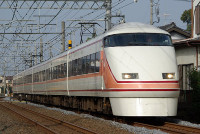
The Tobu 100 series train running between Satte Station and Minami-Kurihashi Station on the Tōbu Isesaki Line
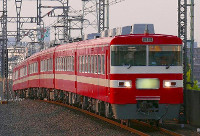
Tobu Railway 1800 series EMU set 1819 approaching Shin-Koshigaya Station on a seasonal Rapid working
The Kameido Line
The Tobu Kameido Line (東武亀戸線 Tōbu Kameido-sen) is a railway line of Japanese private railway company Tobu Railway in Tokyo. The line is in central Tokyo, a short 3.4 km branch off the Tobu Skytree Line at Hikifune, southbound to Kameido with connections to the JR East Chūō-Sōbu Line. The line was opened in 1904, and electrified in 1928. All trains are "Local" with no through services to the Tobu Skytreeline
Station List
Here is the station list of the Kamiedo Line from Hikifune (for transfers to other lines look at the page of the station).
Current Rolling Stock
Tobu 8000 Series
The Daishi Line
The Tobu Daishi Line (東武大師線 Tōbu Daishi-sen) is a 1.0 km railway line in Adachi, Tokyo, Japan, owned and operated by Tobu Railway. It connects Nishiarai Station to Daishimae Station.
This line forms part of the proposed Tobu Nishi-Ita Line (東武西板線) which was never completed. The Tōbu Nishi-Ita line was intended to link the Tobu Skytree Line and Tobu Tojo Line to allow efficient transfer of rolling stock, and improve the service for residents along the line.
History
The line opened on December 20, 1931, as the Tobu Nishi-Ita Line from Nishiarai to Daishimae, with a total distance of 1.1 km. Operation was suspended from May 20, 1945. Operations resumed from May 21, 1947, with the line renamed Tōbu Daishi Line.
On December 1, 1968, Daishimae station was relocated due to road extension, shortening the line by 100 m. On July 26, 1991, the track was elevated.
Wanman driver-only operation started on March 19, 2003.
Stations
Here is the station list of the Dashi Line from Nishirai (for transfers to other lines look at the page of the station).
Current Rolling Stock
Tobu 8000 Series
The Urban Park Line
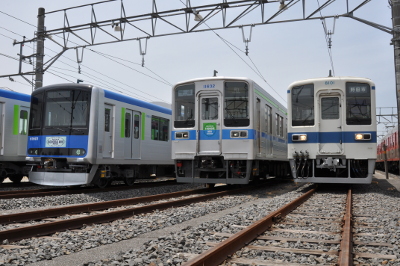
A lineup of Tobu Urban Park Line rolling stock at the line's Nankodai Depot, June 2013
The Tobu Urban Park Line (東武アーバンパークライン Tōbu Ābanpāku-rain), formally known as the Tobu Noda Line (東武野田線 Tōbu Noda-sen), is a 62.7 km (39.0 mi) long railway line in Saitama and Chiba Prefectures operated by the Japanese private railway company Tobu Railway. It connects the satellite cities of Tokyo, such as Saitama, Kasukabe, Noda, Nagareyama, Matsudo, Kamagaya, Kashiwa, and Funabashi.
The tracks of the Urban Park Line are between Ōmiya - Kasukabe, Unga - Sakasai and Mutsumi - Funabashi double and the rest is single.
Operations
All trains are operated as all-stations "Local" services. Most trains, excluding a few from/to train depots, originate or terminate at Kashiwa Station which has a switchback. During the daytime, six trains run per hour. All trains stop at all stations.
History
The line first opened as the Chiba Prefectural Railway Noda Line (千葉県営鉄道野田線 Chiba Ken'ei Tetsudō Noda-sen) on 9 May 1911, from Kashiwa to Nodamachi (now Nodashi), a distance of 14.7 kilometres (9 miles 10 chains) using steam haulage. In 1923, the line was privatized and the operator was named Hokusō Railway (北総鉄道 Hokusō Tetsudō) (separate from the present Hokusō Railway), and also opened its own line from Funabashi Station to Kashiwa Station, a distance of 19.6 km (12 mi 14 ch).
The company gradually extended the line to Ōmiya, and changed its name in 1929 to Sōbu Railway (総武鉄道 Sōbu Tetsudō) (not to be confused with the present Sōbu Main Line). The line was completed in 1930 with the completion of the bridge over the Edo River.
On 1 March 1944, the company merged with the Tobu Railway, and the line became the Tobu Noda Line. 6-car trains were introduced from November 1972.
Electrification was commenced in 1929 between Kasukabe and Ōmiya, and while the section from Kashiwa to Funabashi was still unelectrified when the operation of the line was taken over by Tobu in 1944, the remaining section was electrified by 1 March 1947.
The Omiya to Kasukabe section was double-tracked between 1957 and 2011, the Nodashi to Umesato section in 2011, the Unga to Sakasai section between 1960 and 1991, and the Mutsumi to Funabashi section between 1964 and 1999.
Six-car 8000 series EMUs were phased in from 1997, displaced by new 30000 series EMUs introduced on the Tobu Isesaki Line. The last remaining 5070 series EMUs were withdrawn from the start of the revised timetable on 19 October 2004, and the line's maximum speed was raised from 90 km/h to 100 km/h at the same time.
From 17 March 2012, station numbering was introduced on all Tobu lines, with Noda Line stations receiving numbers prefixed with the letters "TD".
From 1 April 2014, the line received a nickname called Tobu Urban Park Line (東武アーバンパークライン).
Limited-stop "Express" services are scheduled to be introduced from 2016 on the section between Omiya and Kasukabe.
Station List
Here is the station list of the Urban Park Line from Omiya (for transfers to other lines look at the page of the station).
- Omiya
- Kita Omiya
- Omiya Koen
- Owada
- Nanasato
- Iwatsuki
- Higashi Iwatsuki
- Toyoharu
- Yagisaki
- Kasukabe
- Fujino Ushijima
- Minami Sakurai
- Kawama
- Nanakodai
- Shimizu Koen
- Atago
- Nodashi
- Umesato
- Unga
- Edogawadai
- Hatsuishi
- Nagareyama Otakanomori
- Toyoshiki
- Kashiwa
- Shin Kashiwa
- Masuo
- Sakasai
- Takayanagi
- Mutsumi
- Shin Kamagaya
- Kamagaya
- Magomezawa
- Tsukada
- Shin Funabashi
- Funabashi
Current Rolling Stock
Trains are formed of 6-car (or 4+2-car) 8000 series EMUs, introduced from 1997. New 6-car 60000 series EMUs were introduced on the line from 15 June 2013, replacing the older 8000 series sets. Eight sets are scheduled to be delivered by the end of fiscal 2013.
From 3 March 2012, test running using 10030 series EMUs commenced on the line, with the first reliveried set entering revenue service from 20 April 2013.
8000 series 6-car (including 2+4-car) EMUs (since 3 June 1977)
10000 series 6-car EMUs (since 20 April 2013)
60000 series 6-car EMUs (since 15 June 2013)
The Nikko Line
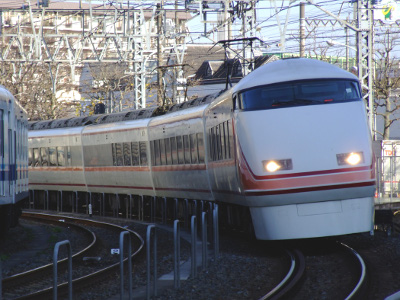
Tobu Railway series 100, which is used for Limited Express bound for Nikko or Kinugawa
The Tobu Nikko Line (東武日光線 Tōbu Nikkō-sen) is a 94.5 km railway line in Japan operated by the private railway company Tobu Railway. It branches from Tōbu Dōbutsu Kōen Station in Miyashiro, Saitama on the Skytree Line, extending north to Tōbu Nikkō Station in Nikkō, Tochigi.
The line has two branch lines: the Utsunomiya Line at Shin-Tochigi Station in Tochigi, Tochigi, and the Kinugawa Line at Shimo-Imaichi Station in Nikkō.
Service Patterns
Stops and service patterns are as of March 2013.
Local (普通 Futsū) (L)
Stops at all stations on the Nikko Line. Through to/from Naka-Meguro on the Tokyo Metro Hibiya Line and Asakusa
Stops at all stations on the Nikko Line, limited-stop service on the Isesaki Line.
Semi-Express (準急 Junkyū) (SmE)
Stops at all stations on the Nikko Line, limited-stop service on the Isesaki Line. Through to/from Chūō-Rinkan on the Tokyu Den-en-toshi Line via the Tokyo Metro Hanzomon Line
Section Express (区間急行 Kukan Kyūkō) (SE)
Stops at all stations on the Nikko Line, limited-stop service on the Isesaki Line.
Express (急行 Kyūkō) (Ex)
Stops at all stations on the Nikko Line, rapid service on the Isesaki Line. Through to/from Chūō-Rinkan on the Tokyu Den-en-toshi Line via the Tokyo Metro Hanzomon Line
Section Rapid (区間快速 Kukan Kaisoku) (SR)
Stops at all stations on the Nikko Line, the same stops on the Isesaki Line as Rapid trains. Complements Rapid services during the daytime
Rapid (快速 Kaisoku) (R)
Limited Express (特急 Tokkyū) (LE)
Stops not shown. Seat reservation fee applies, from Asakusa to Tobu Nikko and Kinugawa Kōen.
History
The Nikko Line opened (dual track and electrified) on 1 October 1929.
In 1943, the section north of Kassemba was reduced to single track and the recovered rails used to build the Tobu Kumagaya Line.
Electric limited express services first started operating from February 1949. From October 1960, new 1720 series "Deluxe Romance car" EMUs were introduced on limited express services to and from Nikko.
The Kassemba to Nikko section was returned to dual track from north to south, commencing with the Nikko to Shimo-Imachi section in 1955, extended to Myojin the following year, the section to Shin-Kanuma between 1963 and 1965, and to Kassemba in 1973.
From 1 June 1990, new 100 series "Spacia" EMUs were introduced on limited express services, and the maximum speed of these was raised to 120 km/h in 1992.
A connecting track at Kurihashi was built to the JR-East Tōhoku Main Line (Utsunomiya Line) from 18 March 2006, allowing through-operations of Nikkō and Kinugawa limited express services to/from Ōmiya, Ikebukuro, and Shinjuku.
Former connecting lines
Nikko Station:
The Nikko Electric Railway Co. opened an 8km line electrified at 600 V DC to Iwanohana between 1907 and 1913, and extended it 2km to Umakae (approximately 300 m higher than Nikko) in 1931 to connect to a 1.2km funicular railway that climbed 428m which opened in 1932. In 1944, electric locomotives began hauling copper ore on the line. Freight tonnage decreased 25% between 1964 and 1966, and passenger numbers decreased by 17% over the same period, resulting in the line closing in 1968. The funicular railway closed in 1970.
Station List
Here is the station list of the Nikko Line from Tobu Dobutsu Koen (for transfers to other lines look at the page of the station).
- Tobu Dobutsu Koen
- Sugito Takanodai
- Satte
- Minami Kurihashi
- Kurihashi
- Shin Koga
- Yagyu
- Itakura Toyodai Mae
- Fujioka
- Shizuwa
- Shin Ohirashita
- Tochigi
- Shin Tochigi
- Kassemba
- Ienaka
- Tobu Kanasaki
- Niregi
- Momiyama
- Shin Kanuma
- Kita Kanuma
- Itaga
- Shimo Goshiro
- Myojin
- Shimo Imaichi
- Kami Imaichi
- Tobu Nikko
Current Rolling Stock
Tobu 100 Series
Tobu 300 Series
Tobu 350 Series
Tobu 634 Series
Tobu 6050 Series
Tobu 10030 Series
Tobu 10050 Series
Tobu 20000 Series
Tobu 20050 Series
Tobu 20070 Series
Tobu 30000 Series
Tobu 50050 Series
Tokyo Metro 03 Series
Tokyo Metro 8000 series
Tokyo Metro 08 series
Tokyu 2000 series
Tokyu 5000 series
Tokyu 8500 series
Tokyu 8590 series
Aizu 600 Series
Aizu 700 Series
Aizu 6050 Series
Aizu Kiha 8500 Series
JR East 253-1000 Series

The Tobu 100 series train running between Satte Station and Minami-Kurihashi Station on the Tōbu Isesaki Line
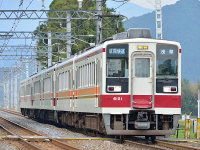
A Tobu 6050 series EMU 6-car formation led by set 6151 on the Tobu Nikko Line on a sectional rapid service for Asakusa
The Utsunomiya Line
The Tōbu Utsunomiya Line (東武宇都宮線 Tōbu Utsunomiya-sen) is a 24.3-kilometre railway line in Tochigi Prefecture, Japan, owned and operated by the private railway operator Tobu Railway. It connects Shin-Tochigi Station in Tochigi with Tobu Utsunomiya Station in Utsunomiya.
Shin-Tochigi Station offers connections to the Tōbu Nikkō Line and the Tōbu Main Line network.
History
The entire line opened in 1931, electrified at 1,500 V DC.
Former connecting lines
In 1897, the Tochigi Prefectural Government opened a 3 km 2 ft (610 mm) gauge line from Nishi-Kawada to Nishihara-cho, extending it 10 km to Yoshihara in 1899 and opening a 4 km branch to Tokujiro the following year. Handcar passenger services commenced on both lines from opening, operating until 1928. A 7.5 km branch from Nishihara-cho to Tateiwa was opened in 1898 to haul gravel.
In 1931, the lines were purchased by the Tobu Railway, which closed all except the Tateiwa branch, which it converted to 1,067 mm (3 ft 6 in) gauge and built a connection to Tsuruta Station on the Nikko Line. The Tateiwa branch ceased operation in 1961 following a landslide and was formally closed in 1964.
Station List
Here is the station list of the Utsunomiya Line from Shin Tochi (for transfers to other lines look at the page of the station).
- Shin Tochigi
- Yashu Hirakawa
- Yashu Otsuka
- Mibu
- Kuniya
- Omocha no Machi
- Yasuzuka
- Nishi Kawada
- Esojima
- Minami Utsunomiya
- Tobu Utsunomya
Current Rolling Stock
Tobu 350 Series EMUs (Shimotsuke Limited Express services)
Tobu 8000 Series 4-car EMUs (all-stations "Local" services)
The Kinugawa Line
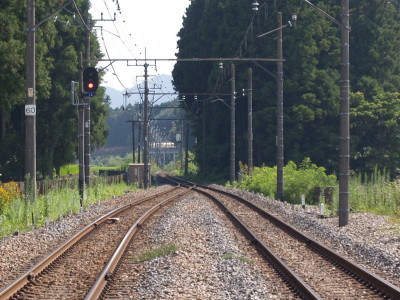
Kido Tateiwa signal station (taken from Kinugawa Onsen side of the railroad crossing)
The Tobu Kinugawa Line (東武鬼怒川線 Tōbu Kinugawa-sen) is a 16.2 km long Japanese railway line from Shimo-Imaichi Station to Shin-Fujiwara Station in Nikkō, Tochigi. It is owned and operated by the private railway operator Tobu Railway. Its name was taken after Kinugawa Onsen hot spring resort area the line serves.
At Shimo-Imaichi Station it connects with the Tobu Nikko Line. At Shin-Fujiwara Station it connects with the Yagan Railway Aizu Kinugawa Line. Some trains goes beyond the Aizu Kinugawa Line terminus at Aizu-Kōgen Oze-guchi Station onto the Aizu Railway Aizu Line.
The line runs surcharged, reserved-seat limited express services from and to Asakusa and Shinjuku in Tokyo.
The whole line is electrified at 1,500 V DC, but it is single tracked except for a 0.8 km double-tracked section at Kinugawa-Onsen Station.
History
Former connecting lines
Shin-Takatoku station - The Tobu Yaita Line operated between 1924 and 1959.
Station List
Here is the station list of the Kinugawa Line from Shimo Imachi (for transfers to other lines look at the page of the station).
Current Rolling Stock
Tobu 100 Series
Tobu 634 Series
Tobu 6050 Series
Aizu 600 Series
Aizu 700 Series
Aizu 6050 Series
Aizu Kiha 8500 Series

The Tobu 100 series train running between Satte Station and Minami-Kurihashi Station on the Tōbu Isesaki Line
The Sano Line
The Tobu Sano Line (東武佐野線 Tōbu Sano-sen) is railway line in Japan, operated by the private railway operator Tobu Railway, connecting Tatebayashi Station in Tatebayashi city, Gunma Prefecture, in a north-north-easterly direction to Kuzū Station in Sano, Tochigi Prefecture.
In February 2005, the old city of Sano, the town of Tanuma and the town of Kuzu were merged into the city offer Sano, so this line runs within the two cities of Tatebayashi, Gunma and Sano, Tochigi.
History
The Aso Horse Tramway opened the first section of the line between Kuzu and Koena-kashi to haul limestone and timber to the Watarase river port in 1889/90. Individual section opening dates are provided below. Steam locomotion was introduced in 1894, and in 1912 the company merged with Tobu. The line was extended to Tatebayashi in 1914, and electrified in 1927.
Station List
Here is the station list of the Sano Line from Kuzū (for transfers to other lines look at the page of the station).
Current Rolling Stock
Tobu 200 Series
Tobu 250 Series
Tobu 8000 Series
The Koizumi Line
The Tōbu Koizumi Line (東武小泉線 Tōbu Koizumi-sen), operated by the private railway operator Tobu Railway, connects Tatebayashi Station located in Tatebayashi, Gunma to Nishi-Koizumi Station located in Ōizumi, Gunma as well as Higashi-Koizumi Station in Ōizumi town to Ōta Station in Ōta, Gunma Japan.
History
The first section of the line from Tatebayashi Station to Koizumimachi Station was opened for passenger service on March 12, 1917, operated by the Chūgen Railway, which was purchased by Tobu Railway company in 1937.
The 3 km Sengokugashi Freight Line (仙石河岸貨物線) from Koizumimachi Station to Sengokugashi Station (仙石河岸駅) opened on April 13, 1939, as a freight-only branch line. Passenger services as far as Nishi-Koizumi commenced in 1941.
In 1941, Higashi-Koizumi Station to Ōta Station section opened on June 1, 1941, to service the Nakajima Aircraft Company Ōta and Koizumi plants. The lines were electrified in 1943.
The Nishi-Koizumi to Sengoku freight branch closed in 1976, and freight services ceased on the line in 1996.
Stations
Here is the station list of the Sano Line from Kuzū (for transfers to other lines look at the page of the station).
Main Line
Branch LineCurrent Rolling Stock
Tobu 8000 Series

